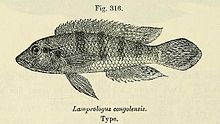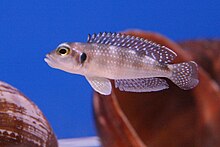Lamprologus
| Lamprologus | ||||||||||||
|---|---|---|---|---|---|---|---|---|---|---|---|---|

Tanganyika snailfish ( Lamprologus ocellatus ) |
||||||||||||
| Systematics | ||||||||||||
|
||||||||||||
| Scientific name | ||||||||||||
| Lamprologus | ||||||||||||
| Schilthuis , 1891 |
The genus Lamprologus belongs to the cichlids (Cichlidae) and consists of 19 species. It occurs in Lake Tanganyika and the Congo of tropical Africa .
features
The size of the fish varies between about four and 20 centimeters. The body is elongated, with the species living in the Congo almost round in cross section. In terms of color, there are many different patterns with the colors white, yellow, red, brown, black, gray and silver. The teeth are conical , both jaws have large fangs in front. The females are about a third smaller than the males. Eyes and lips are darker in color, the scales sometimes shine bluish-silver ( Greek lamprologus = shiny). The anal fin has 4 to 10 spines. The scales are small to medium in size. Lamprologus species feed on small crustaceans , mosquito larvae and other small invertebrates. The fish are oviparous cave breeders . The territory is mostly defended by the males, while the females take care of the spawn.
Systematics
- Species of the Lower Congo
- Lamprologus congoensis Schilthuis, 1891 , type species
- Lamprologus lethops Roberts & Stewart, 1976 , rapids in the lower Congo
- Lamprologus markerti Tougas & Stiassny, 2014
- Lamprologus teugelsi Schelly & Stiassny, 2004
- Lamprologus tigripictilis Schelly & Stiassny, 2004
- Lamprologus tumbanus Boulenger, 1899 , Lake Tumba
- Lamprologus werneri Poll, 1959
- Species of the Upper Congo
- Lamprologus mocquardi Pellegrin, 1903
- Lamprologus symoensi Poll, 1976
- Species of Lake Tanganyika
- Lamprologus callipterus Boulenger, 1906
- Lamprologus finalimus Nichols & La Monte, 1931
- Lamprologus kungweensis Poll, 1956
- Lamprologus laparogramma Bills & Ribbink, 1997
- Lamprologus lemairii Boulenger, 1899
- Lamprologus meleagris Büscher, 1991
- Tanganyika snail perch ( Lamprologus ocellatus (Steindachner, 1909) )
- Lamprologus ornatipinnis Poll, 1949
- Lamprologus signatus Poll, 1952
- Lamprologus speciosus Büscher, 1991
- Lamprologus stappersi Pellegrin, 1927
literature
- David H. Eccles: Field Guide to the Freshwater Fishes of Tanzania. FAO Species Identification Sheets for Fishery Purposes, Rome, 1992, p. 99.
- Georg Zurlo, Anton Lamboj : Lamprologus […]. In: Claus Schaefer, Torsten Schröer (Hrsg.): The large lexicon of aquaristics. Eugen Ulmer, Stuttgart 2004, ISBN 3-8001-7497-9 , pp. 568-571
Web links
- Lamprologus on Fishbase.org (English)


